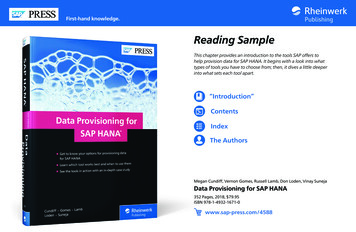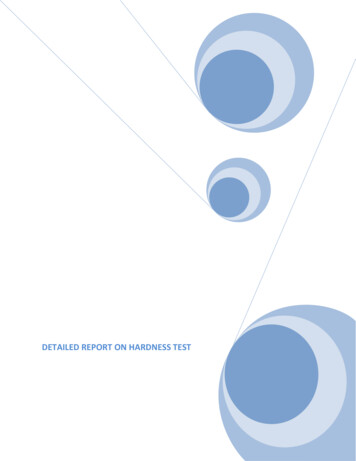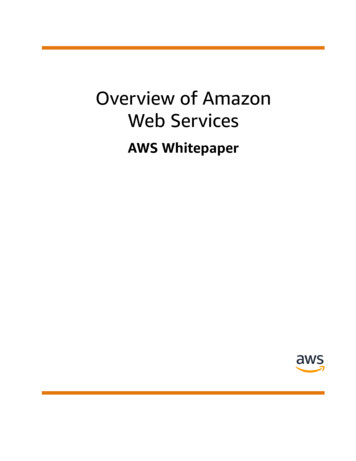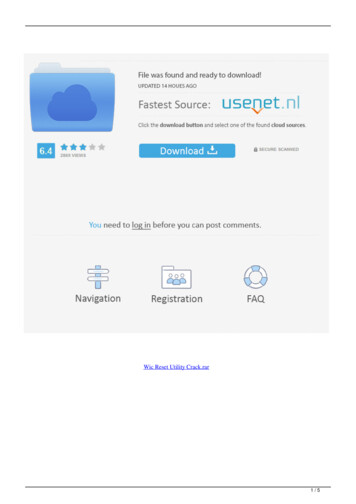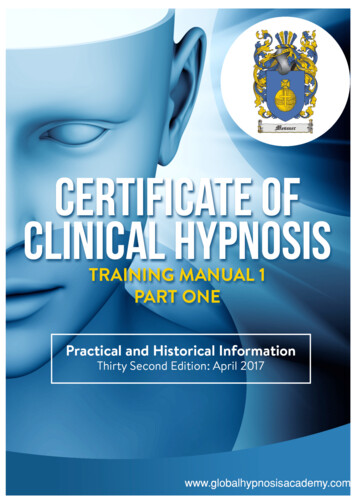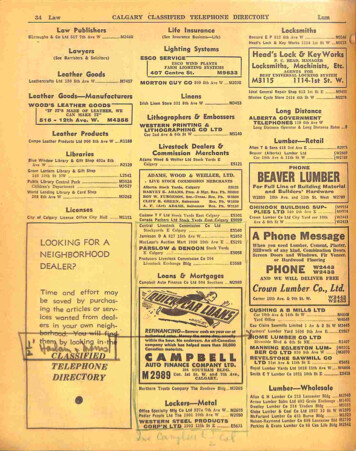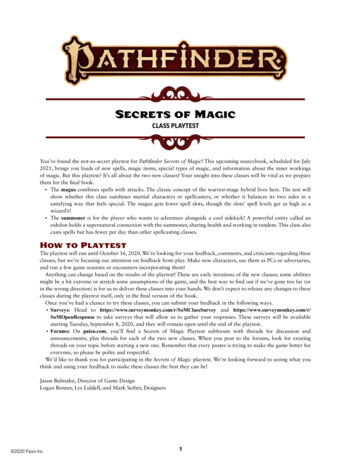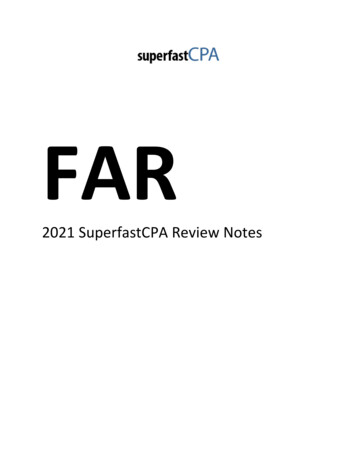
Transcription
FAR2021 SuperfastCPA Review Notes
Table of ContentsConceptual Framework and Financial ReportingConceptual FrameworkConceptual FrameworkStandard Setting ProcessGeneral Purpose Financial StatementsBalance sheetIncome statementStatement of comprehensive incomeStatement of changes in equityStatement of cash flowsNotes to financial statementsConsolidated financial statementsDiscontinued operationsGoing concernFinancial Statements for NonprofitsStatement of financial positionStatement of activitiesStatement of cash flowsPublic company reporting topicsFinancial statements of employee benefit plansSpecial purpose frameworksFinancial Statement AccountsCashReceivablesInventoryProperty, plant, and equipmentInvestmentsFinancial assets at fair valueFinancial assets at amortized costEquity method investmentsIntangible assetsPayables and accrued liabilitiesLong-term 8586264677073
EquityRevenue recognitionCompensation and benefitsIncome taxesSelect TransactionsAccounting changes and error correctionsBusiness combinationsContingencies and commitmentsDerivatives and hedge accountingForeign currency transactionsLeasesNonreciprocal transfersResearch and development costsSoftware costsSubsequent eventsFair value measurementsGAAP vs IFRSGovernmentState and Local Government ConceptsConceptual FrameworkMeasurement focus and Basis of AccountingPurpose of fundsFormat & Content of the CAFRGovernment-wide financial statementsGovernmental funds financial statementsProprietary funds financial statementsFiduciary funds financial statementsNotes to financial statementsManagement's discussion and analysisBudgetary comparison reportingRequired supplementary informationFinancial reporting entity, blended & discrete unitsTypical Items & Specific TransactionsNet position and components thereofFund 0150151
Capital assetsGeneral and proprietary liabilitiesInterfund activity & transfersNonexchange revenue transactionsExpenditures and expensesSpecial itemsBudgetary accounting & encumbrancesOther financing sources and uses152153154155157158159162
InvestmentsFinancial Assets at Fair ValueFor Equity Securities:All equity securities are required to be recorded at fair value whenfair value can be readily determined (see exceptions below).Dividends from equity securities are included in net income.Exceptions to carrying equity securities at fair value:Investments in equity securities will be carried at fair value unless:1. There is significant influence over the investee and theequity method is used2. The investment will be consolidated and therefore eliminated3. The fair value of the investment cannot be readilydetermined. In this case, the investment will be recorded atcost and adjusted for any impairmentsEquity Securities Example:ABC purchased 10 shares of XYZ for 1,000.Journal entry at purchase:Investment in XYZ 1,000Cash 1,000At the balance sheet date if the fair value of the XYZ shares isnow 1,250:Investment in XYZ 250Unrealized gain 250If ABC received dividends of 50 on their XYZ investment:Cash 50Dividend income 5058Copyright 2021 SuperfastCPA.com
At the next balance sheet date if XYZ investment is nowworth 950:Unrealized loss 300Investment in XYZ 300When the XYZ shares are actually sold for 900:Cash 900Realized loss 50Investment in XYZ 950Equity Securities at CostIf the fair value of the securities cannot be readily determined,then the investor would record the investment at cost.Any dividends received would be included in net income.Such investments would be evaluated for impairment based onany of the following factors: If there’s been a downturn in the earnings performance, creditrating, business outlook of the investee, or concerns aboutthe ability of the investee to continue as a going concern If there’s been a downturn in the economic, regulatory, ormarket conditions the investee operates inIf it is determined the assets are impaired, the impairment loss isequal to the carrying value of the investment less the determinedfair value. In other words, carrying value – fair value theimpairment loss.59Copyright 2021 SuperfastCPA.com
For Debt Securities:The entity has several options for how they carry debt securitiesas investments: The entity will either classify the investment as trading,available-for-sale (AFS), or held-to-maturity. If they have the ability and intent to carry the debt securitiesuntil maturity, then they will be classified as ‘held to maturity’(HTM) If they don’t have the ability to hold until maturity, or if theydon’t plan to hold until maturity, then the investments will beclassified as ‘available for sale’ securities (AFS) If a debt security is acquired with the intent to sell in the shortterm, then it is classified as a trading security For trading securities, both realized and unrealized gains &losses are recognized in the income statementAvailable for Sale SecuritiesThese are debt securities that are “available for sale”. These arereported at fair value on the balance sheet. If the fair valuebecomes greater than the carrying value, then there is anunrealized gain in OCI.Example:ABC purchased a bond from XYZ for 1,000 and classified it asan AFS security.Journal entry at purchase:AFS securities 1,000Cash 1,000At the balance sheet date if the fair value is now 1,250:AFS securities 250Unrealized holding gain (OCI) 25060Copyright 2021 SuperfastCPA.com
When the amortized cost is greater than the fair value of theinvestment, there has been a decline in value of an AFSinvestment. At this point there are two considerations:1: What portion of the decline in value is because of generalmarket conditions? These are unrealized losses in OCI.2: What portion of the decline in value is because of a decline inthe credit worthiness of the investee? These are credit lossesrecognized in income and creates a valuation allowance or contraaccount to the AFS investment.Example:ABC determines that its 100,000 investment in XYZ’s debtsecurities are now worth 95,000. ABC attributes 3,000 to creditloss, and 2,000 to general market conditions.The credit loss entry would be:Credit loss expenseCredit loss allowance 3,000 3,000The portion for general conditions would be:Unrealized loss (OCI) 2,000FV adjustment - AFS securities 2,000These credit losses can be reversed if the situation changes, butonly up to the amount in the credit loss allowance account.61Copyright 2021 SuperfastCPA.com
Financial Assets at Amortized CostHeld to maturity (HTM) debt investments are reported atamortized cost. These are debt securities that the investor intendsto “hold until maturity” of the investment. The fair value option canbe elected for a held to maturity investment, and if so then fairvalue rules apply (see previous section).The investment is recorded at cost (includes brokerage or transferfees if applicable). Unrealized gains and losses aren’t tracked ormeasured for HTM investments.Interest income is recognized in earnings (income statement).Example:ABC purchased a debt investment that it intends to hold untilmaturity. The cost of the investment is 100,000.Journal entry to record investment:HTM investment 100,000Cash 100,000If ABC receives 5,000 in interest income from theinvestment:Cash 5,000Interest income 5,000HTM investments are evaluated for impairment at each balancesheet date. If a decline in fair value is 1) below amortized cost and2) the decline in value is considered other than temporary, theentity evaluates the investment according to the current expectedcredit loss model (CECL). This model is based on historicalexperience and business outlook of the investee, marketconditions in which the investee operates, and forecasts related to62Copyright 2021 SuperfastCPA.com
the investee to come up with all expected credit losses on aninvestment (essentially you’re evaluating the ability of the investeeto repay the debt and come up with the amount the entity actuallyexpects to receive on this debt investment).The expected credit loss amount is then used to create avaluation allowance that is a contra account to the HTMinvestment. This amount is debited to “credit loss expense” on theincome statement, and then credited to “allowance for credit loss”,the contra account which lowers the amortized cost amount onthe balance sheet.Example:ABC evaluates its 100,000 HTM investment and expects a creditloss of 20,000.The entry would be:Credit loss expenseAllowance for credit loss 20,000 20,000So this allowance lowers the value of the HTM investment on thebalance sheet, even though it’s still being carried at its amortizedcost, and it provides the net amount that the entity expects toactually collect on the debt investment.At each balance sheet date these credit losses are re-evaluated,and previous losses can be reversed, but only up to the amount inthe allowance account.63Copyright 2021 SuperfastCPA.com
Equity Method InvestmentsThis is the method used when an investor owns more than 20%but less 50% of voting shares in an entity and/or has “significantinfluence” over the investee (more than 50% ownership wouldrequire consolidation).It’s possible to own 21-49% and still not have significant influenceif the investee opposed investor, another investor owns more and“blocks” your interests, you don’t have representation on theboard. In this case the fair value option would be used.Also, you can own less than 20% and HAVE significant influenceif you own the highest % of stock, if you have representation onthe board, or are technologically interdependent with the investee.In this case the equity method could be used.If the investment is greater than the proportionate FV of netassets, the excess is goodwill. However, the goodwill from theequity method is not separated on the balance sheet, it is justincluded in the investment account.If an entity was accounting for an investment with anothermethod, and then switched to the equity method, that change willbe applied prospectively.Recording the investment:The cost of the investment is recorded as “Investment in XYZ”.Example:ABC corp makes an investment in XYZ corp that equals 30% ofthe stock of XYZ and gives ABC significant influence. The cost ofthe investment was 100,000.Entry to record investment:64Copyright 2021 SuperfastCPA.com
Investment in XYZCash 100,000 100,000Dividends reduce the investment on your books, and it’s pro-rata:XYZ pays 10,000 in dividends for the year. ABC would makethe following entry:Cash 3,000Investment in XYZ 3,000Dividends received are considered a return of investment andlowers the investment account.Income is the opposite: If XYZ had net income of 30,000,ABC’s “share” as a 30% owner is 9,000. The entry would be:Investment in XYZ 9,000Investment income 9,000If XYZ reported a net loss of 30,000 for the period:Investment loss 9,000Investment in XYZ 9,000ImpairmentAn equity method investment is evaluated for impairment, and ifthe change in FV is considered other than temporary, theinvestment is written down to FV and a loss is recognized inincome.Other equity method facts:The rules for dividends only apply to the common stock of theinvestee. If the investor also had preferred stock, dividends65Copyright 2021 SuperfastCPA.com
received from the preferred stock would be regular dividendincome.If an investment made is more than the book value for theproportionate amount due to an undervalued intangible asset, asthat asset is amortized it will reduce the investment account:Example:ABC purchases 25% of the common stock of XYZ for 500,000.The book value of the shares was 400,000 due to anundervalued intangible asset. ABC determines the useful life ofthe intangible asset to be 10 years, so each year ABC willamortize 10,000, which will reduce ABC’s “investment in XYZ”account by the 10,000.66Copyright 2021 SuperfastCPA.com
Intangible assetsIntangible assets are either created or acquired. They are assetsthat don’t have a physical form but are useful to a business forlonger than a year. Although stocks and other securities soundlike they fit this definition, intangible assets are separate fromfinancial assets or investments.Intangibles either have a definite life, or an indefinite life, but allintangibles can be evaluated for impairment.Identifiable: these can be legally identified such as copyrights,customer lists, patentsUnidentifiable: goodwill2 types of “life” Definite life: has a finite life legally or other factors limit its life⁃ Patents, copyrights⁃ “Useful life” means how long the asset will provide abenefit, not strictly its legal life on paper. If a patentlegally has 20 years left, but management projects it willonly generate cash flows for 10 more years, its usefullife is 10 years Indefinite life: no foreseeable limit on the life of the asset⁃ TrademarksFor definite life intangibles: You capitalize external costs (legal fees, etc.) They are amortized over their useful life on the straight-linemethod There is impairment if book value is greater than recoverablecost Impairment loss is BV - FV67Copyright 2021 SuperfastCPA.com
For indefinite life intangibles: You capitalize external costs They are NOT amortized (although goodwill can beamortized for nonpublic companies straight-line over 10-yearperiod) Impairment loss is BV - FVGoodwillGoodwill is the excess over fair market value of the acquiredcompany’s assets. It represents brand value, customer loyalty,etc.Goodwill can be impaired if it is determined that the carrying valueof the goodwill is greater than its fair value. Goodwill is tested forimpairment at the reporting unit level.Impairment loss on goodwill if the entity’s carrying value ofgoodwill is greater than the entity’s fair value. The differencewould be the impairment loss.Impairment losses on goodwill cannot be reversed oncerecognized.A private(nonp
Notes to financial statements 16 Consolidated financial statements 18 Discontinued operations 21 Going concern 22 Financial Statements for Nonprofits 24 Statement of financial position 24 Statement of activities 25 Statement of cash flows 28 Public company reporting topics 29 Financial statements of employee benefit plans 34

